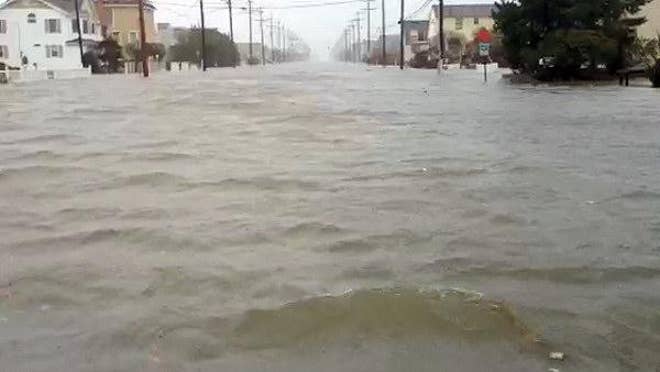As Superstorm Sandy churned slowly inland, millions along the U.S. East Coast awoke Tuesday without power or mass transit, and huge swaths of New York City were unusually dark and abandoned. At least 17 people were killed in seven states.
The storm that made landfall in New Jersey on Monday evening with 80 mph sustained winds cut power to more than 6 million homes and businesses from the Carolinas to Ohio and put the presidential campaign on hold one week before Election Day.
New York was among the hardest hit, with its financial heart closed for a second day and seawater cascading into the still-gaping construction pit at the World Trade Center. The storm caused the worst damage in the 108-year history of New York’s extensive subway system, according to Joseph Lhota, the chairman of the Metropolitan Transportation Authority.
“This will be one for the record books,” said John Miksad, senior vice president for electric operations at Consolidated Edison, which had more than 670,000 customers without power in and around New York City.
Trading at the New York Stock Exchange was canceled again Tuesday — the first time the exchange suspended operations for two consecutive days due to weather since a blizzard in 1888.

President Barack Obama declared a major disaster in New York and Long Island, making federal funding available to residents of the area. The damage is “almost incalculable,” New Jersey Gov. Chris Christie said as he spoke with TV networks Tuesday morning.
New York City’s three major airports remained closed. Overall, more than 13,500 flights had been canceled for Monday and Tuesday, almost all related to the storm, according to the flight-tracking service FlightAware.
Curiosity turned to concern overnight as New York City residents watched whole neighborhoods disappear into darkness as power was cut. The World Trade Center site was a glowing ghost near the tip of Lower Manhattan. Residents reported seeing no lights but the strobes of emergency vehicles and the glimpses of flashlights in nearby apartments. Lobbies were flooded, cars floated and people started to worry about food.
A fire continued to rage in a city neighborhood Tuesday morning near the Atlantic Ocean, with 80 to 100 homes destroyed but no deaths reported.
An unprecedented 13-foot surge of seawater — 3 feet above the previous record — gushed into lower Manhattan, inundating tunnels, subway stations and the electrical system that powers Wall Street and sent hospital patients and tourists scrambling for safety. Skyscrapers swayed and creaked in winds that partially toppled a crane 74 stories above Midtown.
In New Jersey, where the superstorm came ashore, hundreds of people were being evacuated in rising water early Tuesday. Officials were using boats to try to rescue about 800 people living in a trailer park in Moonachie. There were no reports of injuries or deaths. Local authorities initially reported a levee had broken, but Gov. Chris Christie said a berm overflowed.

The massive storm reached well into the Midwest. Chicago officials warned residents to stay away from the Lake Michigan shore as the city prepared for winds of up to 60 mph and waves exceeding 24 feet well into Wednesday.
As Hurricane Sandy closed in on the Northeast, it converged with a cold-weather system that turned it into a monstrous hybrid of rain and high winds — even bringing snow in West Virginia and other mountainous areas inland.
Remnants of the now-former Category 1 hurricane were forecast to head across Pennsylvania before taking another sharp turn into western New York state by Wednesday morning. As of 5 a.m. Tuesday, the storm was centered about 90 miles west of Philadelphia.
Although weakening as it goes, the massive storm — which caused wind warnings from Florida to Canada — will continue to bring heavy rain and local flooding, said Daniel Brown, warning coordination meteorologist at the National Hurricane Center in Miami.
Fox News has the full article











